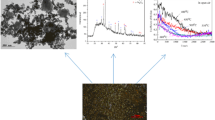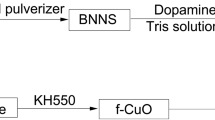Abstract
In this study, the Fe3O4@PEG nanocomposites with core–shell structure were fabricated by a co-precipitation method and characterized by scanning electron microscopy, transmission electron microscopy, Fourier transform infrared spectroscopy, X-ray diffractometer and thermal gravimetric. The physicochemical and tribological properties of the Fe3O4@PEG nanocomposites in aqueous glycerol were systematically evaluated on steel/steel contact for the first time. The aqueous glycerol solution added with 1.0 wt% Fe3O4@PEG showed no obvious precipitation after standing for 72 h and had good dispersion stability. Compared with the base aqueous glycerol, the Fe3O4@PEG nanocomposites exhibited excellent friction-reducing and anti-wear properties at an optimal concentration of 1.0 wt%, with a 41.4% decrease in friction coefficient and a 24.1% reduction in wear volume. Also, the Fe3O4@PEG nanocomposites in aqueous glycerol exhibited superior lubricating performance than unmodified Fe3O4. The boundary lubrication films formed on the surface were attributed to be the main factor in reducing friction and wear, and a possible lubrication mechanism was suggested.











Similar content being viewed by others
References
Martini, A., Ramasamy, U.S., Len, M.: Review of viscosity modifier lubricant additives. Tribol. Lett. 66, 1–14 (2018). https://doi.org/10.1007/s11249-018-1007-0
Lee, S., Muller, M.: Boundary lubrication of oxide surfaces by Poly(L-lysine)-g-poly(ethylene glycol) (PLL-g-PEG) in aqueous media. Tribol. Lett. 15, 231–239 (2003). https://doi.org/10.1023/a:1024861119372
Drobek, T., Spencer, N.D.: Nanotribology of surface-grafted PEG layers in an aqueous environment. Langmuir 24, 1484–1488 (2008). https://doi.org/10.1021/la702289n
Arcifa, A., Rossi, A.: Lubrication of Si-based tribopairs with a hydrophobic ionic liquid: the multiscale influence of water. J Phys. Chem. C. 122, 7331–7343 (2018). https://doi.org/10.1021/acs.jpcc.8b01671
Ju, C., Zheng, D.: Tribological properties of green ILs containing MoS2 quantum dots with one-step preparation. Tribol. Lett. 68, 1–9 (2020). https://doi.org/10.1007/s11249-020-01314-9
Zheng, D., Zhao, Q.: The interaction of two anticorrosive ionic liquid additives on the friction properties of water lubricants. Tribol. Int. 141, 237–249 (2020). https://doi.org/10.1016/j.triboint.2019.105948
Zheng, D., Wang, X.: Anticorrosion and lubricating properties of a fully green lubricant. Tribol. Int. 130, 324–333 (2019). https://doi.org/10.1016/j.triboint.2018.08.014
Zheng, G., Zhang, G.: Tribological properties and surface interaction of novel water-soluble ionic liquid in water-glycol. Tribol. Int. 116, 440–448 (2017). https://doi.org/10.1016/j.triboint.2017.08.001
Bondarev, A.V., Fraile, A.: Mechanisms of friction and wear reduction by h-BN nanosheet and spherical W nanoparticle additives to base oil: experimental study and molecular dynamics simulation. Tribol. Int. (2020). https://doi.org/10.1016/j.triboint.2020.106493
Ren, B., Gao, L.: Tribological properties and anti-wear mechanism of ZnO@graphene core-shell nanoparticles as lubricant additives. Tribol. Int. 144, 106–114 (2020). https://doi.org/10.1016/j.triboint.2019.106114
Wu, X., Zhao, G.: Investigating the tribological performance of nanosized MoS2 on graphene dispersion in perfluoropolyether under high vacuum. RSC Adv. 6, 98606–98610 (2016). https://doi.org/10.1039/c6ra22863a
Yao, Y., Wang, X.: Tribological property of onion-like fullerenes as lubricant additive. Mater. Lett. 62, 2524–2527 (2008). https://doi.org/10.1016/j.matlet.2007.12.056
Chen, L., Xu, H.: Preparation of Cu–Ni bimetallic nanoparticles surface-capped with dodecanethiol and their tribological properties as lubricant additive. Particuology 34, 89–96 (2017). https://doi.org/10.1016/j.partic.2016.12.006
Huang, W., Wang, X.: Study on the synthesis and tribological property of Fe3O4 based magnetic fluids. Tribol. Lett. 33, 187–192 (2009). https://doi.org/10.1007/s11249-008-9407-1
Wang, N., Wang, H.: High-efficient and environmental-friendly PTFE@SiO2 core-shell additive with excellent AW/EP properties in PAO6. Tribol. Int. 158, 106–121 (2021). https://doi.org/10.1016/j.triboint.2021.106930
Lu, Z., Cao, Z.: Preparation and tribological properties of WS2 and WS2/TiO2 nanoparticles. Tribol. Int. 130, 308–316 (2019). https://doi.org/10.1016/j.triboint.2018.09.030
Johnson, D., Hils, J.: Phosphate esters, thiophosphate esters and metal thiophosphates as lubricant additives. Lubricants 1, 132–148 (2013). https://doi.org/10.3390/lubricants1040132
Zhang, X., Sun, W.: Investigation of the tribological properties of two different layered sodium silicates utilized as solid lubrication additives in lithium grease. Ind. Eng. Chem. Res. 53, 182–188 (2013). https://doi.org/10.1021/ie402481u
Ye, C., Liu, W.: Room-temperature ionic liquids: a novel versatile lubricant. Chem .Commun. (Camb). (2001). https://doi.org/10.1039/b106935g
Mello, V.S., Trajano, M.F.: Comparison between the action of nano-oxides and Conventional EP additives in boundary lubrication. Lubricants 8, 5–54 (2020). https://doi.org/10.3390/lubricants8050054
Pham, S.T., Tieu, A.K.: Smart-Responsive Colloidal Capsules as an Emerging Tool to Design a Multifunctional Lubricant Additive. ACS Appl Mater Interfaces. 13, 7714–7724 (2021). https://doi.org/10.1021/acsami.0c20759
Wu, X., Gong, K.: MoS2/WS2 quantum dots as high-performance lubricant additive in polyalkylene glycol for steel/steel contact at elevated temperature. Adv. Mater. Interfaces (2018). https://doi.org/10.1002/admi.201700859
Lee, J., Cho, S.: Enhancement of lubrication properties of nano-oil by controlling the amount of fullerene nanoparticle additives. Tribol. Lett. 28, 203–208 (2007). https://doi.org/10.1007/s11249-007-9265-2
Song, X., Qiu, Z.: Submicron-lubricant based on crystallized fe3o4 spheres for enhanced tribology performance. Chem. Mater. 26, 5113–5119 (2014). https://doi.org/10.1021/cm502426y
Zhou, G., Zhu, Y.: Sliding tribological properties of 0.45% carbon steel lubricated with Fe3O4 magnetic nano-particle additives in baseoil. Wear 301, 753–757 (2013). https://doi.org/10.1016/j.wear.2013.01.027
Liu, L., Jiao, S.: A green design for lubrication: multifunctional system containing Fe3O4@MoS2 nanohybrid. ACS. Sustain. Chem. Eng. 6, 7372–7379 (2018). https://doi.org/10.1021/acssuschemeng.7b04801
Yan, W., Ramakrishna, S.N.: Brushes, graft copolymers, or bottlebrushes? the effect of polymer architecture on the nanotribological properties of grafted-from assemblies. Langmuir 35, 11255–11264 (2019). https://doi.org/10.1021/acs.langmuir.9b01265
Xu, Y., Geng, J.: Lubricating mechanism of Fe3O4@MoS2 core-shell nanocomposites as oil additives for steel/steel contact. Tribol. Int. 121, 241–251 (2018). https://doi.org/10.1016/j.triboint.2018.01.051
Huang, J., Li, Y.: Preparation and tribological properties of core-shell Fe3O4@C microspheres. Tribol. Int. 129, 427–435 (2019). https://doi.org/10.1016/j.triboint.2018.08.036
Zhang, Q., Wu, B.: Preparation, characterization and tribological properties of polyalphaolefin with magnetic reduced graphene oxide/Fe3O4. Tribol. Int. 141, 105952 (2020). https://doi.org/10.1016/j.triboint.2019.105952
Huo, L., Zeng, X.: Enhanced removal of As (V) from aqueous solution using modified hydrous ferric oxide nanoparticles. Sci Rep. 7, 40765 (2017). https://doi.org/10.1038/srep40765
Karimi, S., Namazi, H.: Fe3O4@PEG-coated dendrimer modified graphene oxide nanocomposite as a pH-sensitive drug carrier for targeted delivery of doxorubicin. J. Alloys Compd. 879, 160426 (2021). https://doi.org/10.1016/j.jallcom.2021.160426
Totolin, V., Goecerler, H.: The role of ferric oxide nanoparticles in improving lubricity and tribo-electrochemical performance during chemicalmechanical polishing. Tribol. Lett. 65, 1–12 (2017). https://doi.org/10.1007/s11249-016-0806-4
Acknowledgements
This work was supported by National Key R&D Program of China (2018YFB2000601) and National Natural Science Foundation of China (NSFC 51875553).
Funding
Funding was supported by National Key R&D Program of China, (Grant No. 2018YFB2000601), Natural Science Foundation of China, (Grant No. 51875553).
Author information
Authors and Affiliations
Corresponding authors
Ethics declarations
Conflict of interest
The authors declare no competing financial interest.
Additional information
Publisher's Note
Springer Nature remains neutral with regard to jurisdictional claims in published maps and institutional affiliations.
Rights and permissions
Springer Nature or its licensor holds exclusive rights to this article under a publishing agreement with the author(s) or other rightsholder(s); author self-archiving of the accepted manuscript version of this article is solely governed by the terms of such publishing agreement and applicable law.
About this article
Cite this article
Yang, T., Zhao, Q., Hu, M. et al. Tribological Behavior of Novel Core–Shell Fe3O4@PEG Nano-Additives. Tribol Lett 70, 116 (2022). https://doi.org/10.1007/s11249-022-01656-6
Received:
Accepted:
Published:
DOI: https://doi.org/10.1007/s11249-022-01656-6




